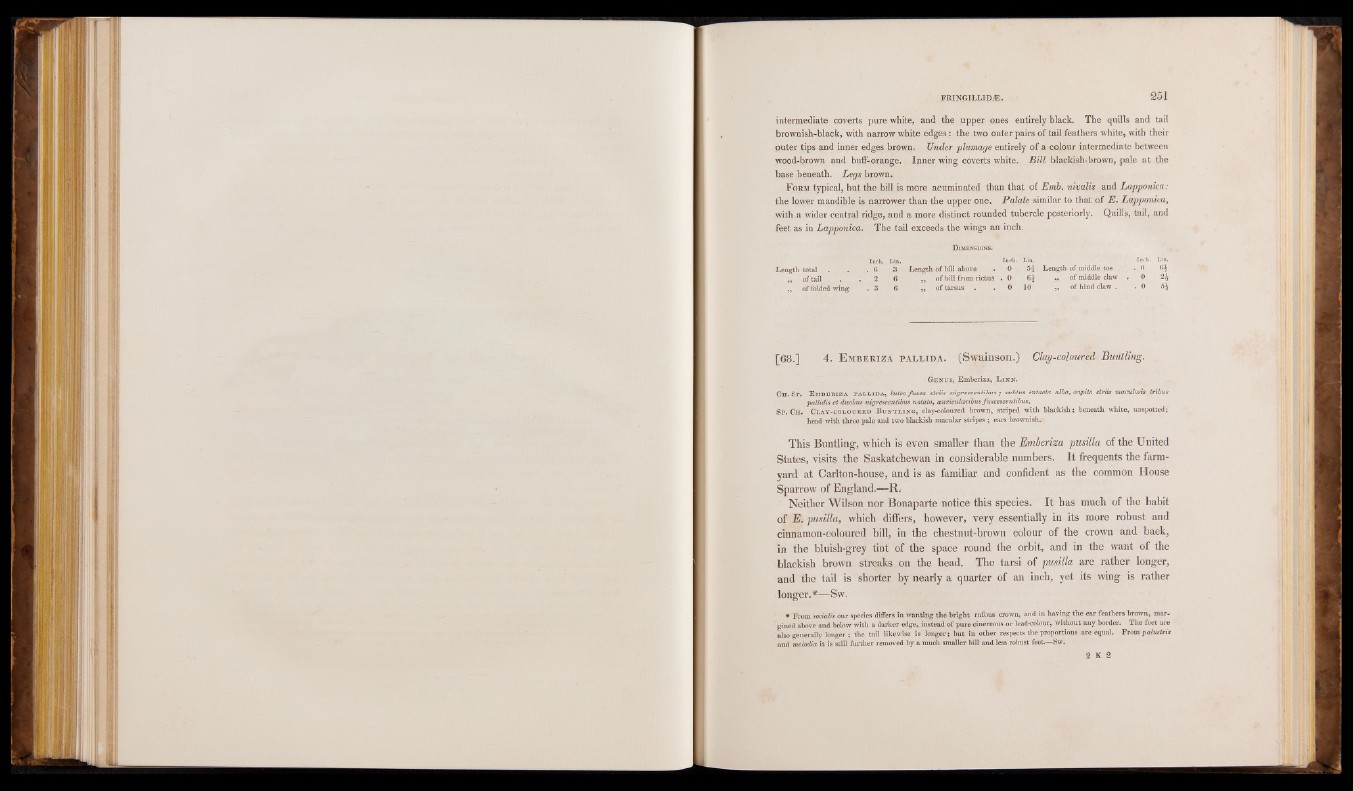
intermediate coverts pure white, and the upper ones entirely black. The quills and tail
brownish-black, with narrow white edges: the two outer pairs of tail feathers white, with their
outer tips and inner edges brown. Under plumage entirely of a colour intermediate between
wood-brown and buff-orange. Inner wing coverts white. Bill blackish-brown, pale at the
base beneath. Legs brown.
F orm typical, but the bill is more acuminated than that of Emb. nivalis and Lapponica :
the lower mandible is narrower than the upper one. Palate similar to that of E. Lapponica,
with a wider central ridge, and a more distinct rounded tubercle posteriorly. Quills, tail, and
feet as in Lapponica,. The tail exceeds the wings an inch.
D im en sio n s.
JncE. Lin. Inch. Lin. ' •' ’ Inch. Lin.
Length total . . . 6 3 Length of bill above . 0 5 | Length of middle toe . 0 6$
„ of tail . . 2 6 „ of bill from rictus . 0 6£ „ of middle claw . 0 2$
„ of folded wing . 3 6 „ of tarsus . . 0 10 „ of hind claw. . 0 5$
[68.] 4. E mberiza pallida. (Swainson.) Clay-coloured Buntling.
Ge n u s , Emberiza, L in n .
Ch. Sp. E m b e b iz a pa l l id a , luteo-fusca striis nigrescentibus ; subtus Intacta alba, capite striis maculosis tribus
pallidis et duobus nigrescentibus notato, auricularibus fuscescentibus.
S p . Ch . Clay -colo u r ed B u n t l in g , day-coloured brown, striped w ith blackish; beneath white, unspotted;
head with three pale and two blackish macular stripes; ears brownish.,.
This Buntling, which is even smaller than the Emberiza pusilla of the United
States, visits the Saskatchewan in considerable numbers. It frequents the farmyard
at Carlton-house, and is as familiar and confident as the common House
Sparrow of England.—R.
Neither Wilson nor Bonaparte notice this species. It has much of the habit
of E. pusilla, which differs, however, very essentially in its more robust and
cinnamon-coloured bill, in the chestnut-brown colour of the crown and back,
in the bluish-grey tint of the space round the orbit, and in the want of the
blackish brown streaks on the head. The tarsi of pusilla are rather longer,
and the tail is shorter by nearly a quarter of an inch, yet its wing is rather
longer.*—Sw.
* From socialis our species differs in wanting the bright rufous crown, and in having the ear feathers brown, mar-
gined above and below with a darker edge, instead of pure cinereous or lead-colour, without any border. The feet are
also generally longer ; the tail likewise is longer; but in other respects the proportions are equal. From palustris
and melodia it is still further removed by a much smaller bill and less robust feet.—Sw.